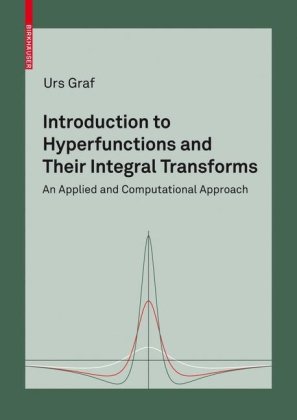

Most ebook files are in PDF format, so you can easily read them using various software such as Foxit Reader or directly on the Google Chrome browser.
Some ebook files are released by publishers in other formats such as .awz, .mobi, .epub, .fb2, etc. You may need to install specific software to read these formats on mobile/PC, such as Calibre.
Please read the tutorial at this link: https://ebookbell.com/faq
We offer FREE conversion to the popular formats you request; however, this may take some time. Therefore, right after payment, please email us, and we will try to provide the service as quickly as possible.
For some exceptional file formats or broken links (if any), please refrain from opening any disputes. Instead, email us first, and we will try to assist within a maximum of 6 hours.
EbookBell Team

0.0
0 reviews
ISBN 13: 9783034604079
Author: Urs Graf
This textbook presents an introduction to the subject of generalized functions and their integral transforms by an approach based on the theory of functions of one complex variable. It includes many concrete examples.
Chapter 1 Introduction to Hyperfunctions
1.1 Generalized Functions
1.2 The Concept of a Hyperfunction
1.3 Properties of Hyperfunctions
1.3.1 Linear Substitution
1.3.2 Hyperfunctions of the Type f(φ(x))
1.3.3 Differentiation
1.3.4 The Shift Operator as a Differential Operator
1.3.5 Parity, Complex Conjugate and Realness
1.3.6 The Equation φ(x)f(x) = h(x)
1.4 Finite Part Hyperfunctions
1.5 Integrals
1.5.1 Integrals with respect to the Independent Variable
1.5.2 Integrals with respect to a Parameter
1.6 More Familiar Hyperfunctions
1.6.1 Unit-Step, Delta Impulses, Sign, Characteristic Hyperfunctions
1.6.2 Integral Powers
1.6.3 Non-integral Powers
1.6.4 Logarithms
1.6.5 Upper and Lower Hyperfunctions
1.6.6 The Normalized Power xα+/Γ(α + 1)
1.6.7 Hyperfunctions Concentrated at One Point
Chapter 2 Analytic Properties
2.1 Sequences, Series, Limits
2.2 Cauchy-type Integrals
2.3 Projections of Functions
2.3.1 Functions Satisfying the H¨older Condition
2.3.2 Projection Theorems
2.3.3 Convergence Factors
2.3.4 Homologous and Standard Hyperfunctions
2.4 Projections of Hyperfunctions
2.4.1 Holomorphic and Meromorphic Hyperfunctions
2.4.2 Standard Defining Functions
Sato’s Decomposition Theorems
Perfect Hyperfunctions and Their Standard Defining Functions
Extension to Non-Perfect Hyperfunctions
Strong Defining Functions
2.4.3 Micro-analytic Hyperfunctions
2.4.4 Support, Singular Support and Singular Spectrum
2.5 Product of Hyperfunctions
2.5.1 Product of Upper or Lower Hyperfunctions
2.5.2 Products in the Case of Disjoint Singular Supports
2.5.3 The Integral of a Product
2.5.4 Hadamard’s Finite Part of an Integral
2.6 Periodic Hyperfunctions and Their Fourier Series
2.7 Convolutions of Hyperfunctions
2.7.1 Definition and Existence of the Convolution
2.7.2 Sufficient Conditions for the Existence of Convolutions
2.7.3 Operational Properties
2.7.4 Principal Value Convolution
2.8 Integral Equations I
Chapter 3 Laplace Transforms
3.1 Loop Integrals
3.2 The Two-Sided Laplace Transform
3.2.1 The Classical Laplace Transform
3.3 Laplace Transforms of Hyperfunctions
3.4 Transforms of some Familiar Hyperfunctions
3.4.1 Dirac Impulses and their Derivatives
3.4.2 Non-negative Integral Powers
3.4.3 Negative Integral Powers
3.4.4 Non-integral Powers
3.4.5 Powers with Logarithms
3.4.6 Exponential Integrals
3.4.7 Transforms of Finite Part Hyperfunctions
3.5 Operational Properties
3.5.1 Linearity
3.5.2 Image Translation Rule
3.5.3 The Multiplication or Image Differentiation Rule
3.5.4 Similarity Rule
3.5.5 Differentiation Rule
3.5.6 Integration Rule
3.5.7 Original Translation Rule
3.5.8 Linear Substitution Rules
3.6 Inverse Laplace Transforms and Convolutions
3.6.1 Inverse Laplace Transforms
The Inversion Formulas
Laplace hyperfunctions
3.6.2 The Convolution Rule
3.6.3 Fractional Integrals and Derivatives
3.7 Right-sided Laplace Transforms
3.8 Integral Equations II
3.8.1 Volterra Integral Equations of Convolution Type
3.8.2 Convolution Integral Equations over an Infinite Range
Chapter 4 Fourier Transforms
4.1 Fourier Transforms of Hyperfunctions
4.1.1 Basic Definitions
4.1.2 Connection to Laplace Transformation
4.2 Fourier Transforms of Some Familiar Hyperfunctions
4.3 Inverse Fourier Transforms
4.3.1 Reciprocity
4.4 Operational Properties
4.4.1 Linear Substitution Rule
4.4.2 Shift-Rules
4.4.3 Complex Conjugation and Realness
4.4.4 Differentiation and Multiplication Rule
4.4.5 Convolution Rules
4.5 Further Examples
4.6 Poisson’s Summation Formula
4.7 Application to Integral and Differential Equations
4.7.1 Integral Equations III
4.7.2 Heat Equation and Weierstrass Transformation
Chapter 5 Hilbert Transforms
5.1 Hilbert Transforms of Hyperfunctions
5.1.1 Definition and Basic Properties
5.1.2 Operational Properties
5.1.3 Using Fourier Transforms
5.2 Analytic Signals and Conjugate Hyperfunctions
5.3 Integral Equations IV
Chapter 6 Mellin Transforms
6.1 The Classical Mellin Transformation
6.2 Mellin Transforms of Hyperfunctions
6.3 Operational Properties
6.3.1 Linearity
6.3.2 Scale Changes
6.3.3 Multiplication by (log x)n
6.3.4 Multiplication by xμ, μ ∈ C
6.3.5 Reflection
6.3.6 Differentiation Rules
6.3.7 Integration Rules
6.4 Inverse Mellin Transformation
6.5 M-Convolutions
6.5.1 Reciprocal Integral Transforms
6.5.2 Transform of a Product and Parseval’s Formula
6.6 Applications
6.6.1 Dirichlet’s Problem in a Wedge-shaped Domain
6.6.2 Euler’s Differential Equation
6.6.3 Integral Equations V
6.6.4 Summation of Series
Chapter 7 Hankel Transforms
7.1 Hankel Transforms of Ordinary Functions
7.1.1 Genesis of the Hankel Transform
7.1.2 Cylinder Functions
7.1.3 Lommel’s Integral
7.1.4 MacRobert’s Proof
7.1.5 Some Hankel Transforms of Ordinary Functions
7.1.6 Operational Properties
Parseval’s Relation
The Similarity and Division Rule
Differentiation Rules
7.2 Hankel Transforms of Hyperfunctions
7.2.1 Basic Definitions
7.2.2 Transforms of some Familiar Hyperfunctions
7.2.3 Operational Properties
introduction to integral equations
introduction to functions transformations of functions independent practice
integral transformations
integral hypergeometric function
integral hyperbolic functions
Tags: Urs Graf, hyperfunctions, integral